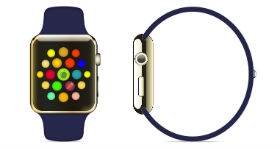As we gear up to the much-anticipated release of the Apple Watch, one wonders how the enterprise could potentially integrate it. Smartwatches in general have been called everything from a solution looking for a rich nerd to already dead (pending improvements). Nonetheless, every major tech company, from Apple to Sony to Huawei, is pushing its own watch. Even Swatch is jumping into the fray.
The questions remains, however: Will the enterprise embrace the Apple Watch?
The answer is that the Apple Watch—and all other good Smartwatches on the market—will be the missing link between the data that machines generate and the people that use it. Fieldworkers could use it as a pager on intelligence steroids, and regular users could gain access to data that helps them more efficiently live their lives and do their jobs.
It’s not a matter of if this evolution will take place. It’s a matter of when app providers can make the smartwatch work effectively for the purpose it was designed for. All signs point to this happening sooner rather than later.
The Attention Problem
 Image via Shutterstock
Image via Shutterstock
The smartwatch is positioned to solve one of the biggest problems of the Information Age, namely data overload. The volume of available digital assets currently overwhelms our human ability to understand them—a phenomenon known as ‘data smog’.
Tech providers have attempted to solve the problem by distilling important data into dashboards or alerts. Rather than synthesizing insights as intended, dashboards and alerts have ended up replicating the original pain, in a different form. The average North American enterprise, for example, receives 10,000 automated security alerts per day, according to CSO.
Faced with data overload, people tune out or turn off. Alert fatigue has long been notorious for causing doctors and nurses to miss important signals, like drug interactions. The problem now extends into almost every industry. The notorious 2013 Target breach happened after the in-house security team turned off alerts, enabling hackers to steal 40 million credit card numbers, which eventually cost the company $61 million to fix.
Users and developers alike are finally realizing that indiscriminately adding alerts and dashboards to an application does not clear the data smog. There has to be a better way for machines to share important data with humans. The smartwatch just might be it.
The Ultimate Data Curation Device
Because communication is so compact on a smartwatch, and the barrier to getting an alert or message is essentially zero—it only takes a perfunctory glance at your wrist—the onus is on developers to make apps so smart that users wonder how they ever lived without a smartwatch.
Anything that interrupts—and all smartwatch apps will—has to be worthwhile. Apps must learn to work with user behavior until they interface on a personal level. If User A never reacts to her sleep monitor, but uses mobile payments all the time, the smartwatch should stop showing sleep alerts and add features to the payments app. If User B is all about his pedometer and sleep monitor, but heats his home with a Franklin stove and has no need for remote thermostat control, his smartwatch apps should also react accordingly.
In an online ecosystem where 69 percent of smartphone and tablet users open an app 10 times or less in a nine-month period, the precision and intelligence of the smartwatch is unprecedented.
A Glorified Pager?
In this pre-mainstream phase, it’s easy to conceive of the smartwatch as little more than a glorified pager. Delivery drivers might make use of it to track last-minute changes in dropoffs and pickups; doctors might gain more refined alerts. In fact, the very thing that makes the smartwatch unique among devices, namely its ability to compact and personalize every single piece of data that it transmits, will also make it more widely applicable than the pager ever was.
The smartwatch’s ability to interact with the iPhone, so that a user can investigate the full details behind an alert, makes the smartwatch more integrated than a standalone pager. Furthermore, smartwatch apps can leverage data from smartphones to further personalize alerts, for example accessing a phone’s GPS to figure out where a person is and sending a traffic alert prior to an important meeting.
A smartwatch can notify a salesperson when a deal is at risk, or give advance notice that a team is slated to miss its targets. Operations workers can receive real-time metrics about the health of their company’s website or stack infrastructure; restaurant managers can use it to spot check employees.
Field professions will likely experience the fastest adoption, but the potential is limitless. If the smartwatch, like the tablet and smartphone before it, come into the enterprise in a BYOD fashion, companies will find new uses for it, from policy enforcement to new types of management systems.
A Matter of Time
How far will the smartwatch’s impact stretch? If the smartwatch manufacturers have their way, the regular watch will disappear entirely in favor of its new digitized offspring. Technology will integrate into style, and the smartwatch, like the rotary watches before it, will become a natural part of your self-expression—and a new way of working.
May the smartest, most stylish watch win.
About the Author: Marius Moscovici is the Co-Founder & CEO of Metric Insights.
Edited by
Dominick Sorrentino